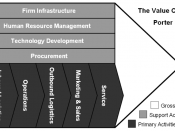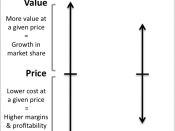To analyse the specific activities through which firms can gain a competitive advantage, it is useful to model the firm as a chain of value creating activities. For this purpose, Porter identified a range of interrelated generic activities common to a wide range of firms. The resulting model is known as the value chain.
According to Porter (1985),
" Competitive Advantage arises out of the way firms organise and arrange discrete activities".
Through using the Value Chain, the activities performed by a firm competing in a particular industry can be grouped into categories as shown in the model below:
Upstream Activities Downstream Activities
Porter distinguishes between primary activities and support activities. Primary activities are directly concerned with the creation or delivery of a product or service. The goal of the primary activities is to create value that exceeds the cost of providing the product or service and therefore generating a profit margin.
They can be grouped into five main areas:
1. Inbound Logistics: Includes the receiving, warehousing and inventory control of input materials
2. Operations: The value creating activities that transform the inputs into the final product
3. Outbound logistics: activities required to get the finished product to the customer e.g. order fulfilment
4. Marketing and sales: Activities associated with getting buyers to buy the product e.g. advertising
5. Service: Activities that maintain and enhance the products value e.g. customer service
Each of these primary activities is linked to support activities, which help to improve their effectiveness or efficiency.
There are four main areas of support activities:
1. Procurement: Purchasing of raw materials and other inputs used in the value creation process
2. Technology development (including R&D): Process automation and other technology development used to support the value chain activities
3. Human Resource Management: Recruitment, development and compensation of...


